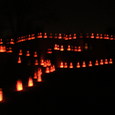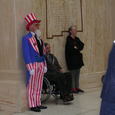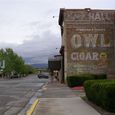As we know, one can often find more careful and truthful political analysis on certain blogs than one can in the mainstream media. Political scientist Philip Klinkner, with a number of excellent books in print that analyze election and demographic data, offers a fresh and compelling analysis of the presidential election results on the blog Polysigh. He points to an increase in support for Bush from monied classes, rather than from churchgoers, as a primary reason for his win:
I've been reviewing the results and exit polls for 2000 and 2004 and I'm not convinced that Bush's victory was due to his turning out religious conservatives in great numbers.
1. Bush's gains were not concentrated in any particular geographic region. He improved a bit more in the South than in other regions, but his swing in the vote was pretty consistent around the country. Among the top 10 states with the biggest swing toward Bush were Hawaii (+7.3), Rhode Island (+6.9), New York (+5.5), New Jersey (+5.5), Connecticut (+5.10). These states are hardly a part of the Bible Belt. These shifts might reflect the influence of Catholic voters, who did shift to Bush, but I'll have to look at the county-level data.
[. . .]
3. Turnout and support for Bush among those who attend church weekly or more did not change since 2000. In 2000, those attending church weekly or more were 42 % of the electorate and gave Bush 59% of their votes, for a Bush performance of 25% (performance = % of electorate X % of support for Bush). In 2004, these voters were 41% of the electorate and gave Bush 61% of their votes, for a Bush performance of 25%--no change from 2004.
4. Bush picked up votes among city dwellers. He was up 10 points among those in urban areas, but only up 3 points with suburbanites. Bush actually fell two points among rural voters.
5. In contrast to the lack of change along religious lines, there was change along class lines. In 2000, those making more than $50,000 made up 53% of the electorate and gave 52% of their votes to Bush, for a Bush performance of 25%. In 2004, those making over $50,000 made up 55% of the electorate and gave 56% of their votes to Bush, for a Bush performance of 31%. Also, these shifts were concentrated in the highest end of the income spectrum. Those making more than $100,000 went from 15 % of the electorate in 2000 to 18% in 2004, and Bush' support in this group went from 54 to 58 percent, causing Bush's performance to increase from 8% to 10%. In fact, this jump of 2% points performance was what allowed George W. Bush best John Kerry.
Read the entire blog entry for more, including a chart of results analyzed according to these categories.














































